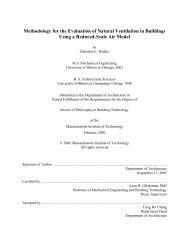DSTL (PDF) - Cham
DSTL (PDF) - Cham
DSTL (PDF) - Cham
You also want an ePaper? Increase the reach of your titles
YUMPU automatically turns print PDFs into web optimized ePapers that Google loves.
strong currents are associated with the transformation process. Also the dissipation ratespredicted are at the high end of the varied oceanographic measurements shown in Figure 9([11], [12], University of Wales, Bangor private communication) and so the transformationprocess is expected to contribute significantly to enhanced mixing and sediment resuspension.Figure 10 shows the shear distribution and flow velocity distribution as anelevation wave is forming and the maximum bed stress as a function of range. According tothe Shields criterion [13] a bed shear stress of 2N/m 2 is sufficient to lift fine sand particleswith diameter ~ 0.1mm so there is the potential for fine sediment re-suspension. If this is thecase then Figure 11 shows the effect of the wave in transporting re-suspended sediment(modelled initially as a passive scalar source between 15km and 16.5km range) up into thewater column and towards the shore.2. Dispersal effects due to passage of large amplitude internal waves off the Malin Shelf(north west coast of Scotland)The Shelf Edge Study Acoustic Measurement Experiment (SESAME associated with theShelf Edge Study (SES)) took place in the summer of 1995 off the north west coast ofScotland. SESAME was sponsored by the UK Ministry of Defence (MOD) of which Dstlforms part. One aspect of this exercise involved measurements of large amplitude (~50m)internal waves travelling towards the coast from the Malin Shelf at ~0.5m/s. Figure 12 showsthe location of study and detail of soliton tracks derived from Synthetic Aperture Radar (SAR)imagery.A typical lead soliton density profile and range velocity distribution obtained from one of themeasurement stations S140 (where the water depth was 140m) were used for the PHOENICSsimulation; these initial fields are shown in Figure 13 and were employed to investigate theeffects of the passage of such waves on the dispersal of neutrally buoyant material initiallylocated at different depths. For this particular case, turbulence was not modelled as the maininterest was in the effect of advection. A similar spatial discretisation to the first case studywas used but a longer time step was possible because elevation waves were not beingsimulated. Cyclic boundary conditions were used in the x direction to simulate repeatedpassage of such waves so a relatively short range section of ~2km was sufficient.The results are shown in Figure 14 covering a time period of about one hour. The coloursrelate to concentration values initially set to unity at the three depths shown in the top left ofthe figure. The dark solid lines are isopycnals and the white solid lines are Richardson numbercontours indicating areas were turbulence is expected from flow instability. The results showsignificant transport effects both towards and away from the shore at mid-depth and near thesurface and also reductions in the levels of concentration due to distortion of the initialmaterial volume by shear in the wave. Near the bottom, there is less of an effect.DISCUSSIONIn general the results achieved are considered reasonable. However, for the first case inparticular, which tracks an internal wave over a distance of 20km very large amounts ofcomputing time are needed. Part of this is due to the requirement for very small time stepsbecause of a first order accuracy restriction on the standard PHOENICS time discretisation.This situation can be improved by use of higher order temporal schemes as suggested in [14].Both simulations use Cartesian grids which are attractive because they are orthogonal andcomputationally efficient. However, the stepped geometry representation of variable bottom4
















